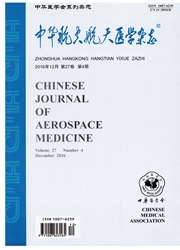

 中文摘要:
中文摘要:
目的 探讨跳伞半蹲式着陆时内、外踝压力大小与受试者体质指数之间的相关性.方法 测量13名现役军事跳伞员的身高、体重,计算BMI.受试者分别从0.6m高平台跳下,模拟跳伞半蹲式着陆,记录着陆时双足内、外踝所受压力. 结果 在模拟跳伞半蹲式着陆时双足内踝所受平均压力明显高于外踝(t=9.605、9.392,P<0.01).左足内踝、右足内踝、左足外踝、右足外踝所受平均压力与体质指数之间的相关系数分别为0.898、0.890、0.824、0.833,且均具有直线相关性.结论 模拟跳伞半蹲式着陆时内、外踝所受压力与体质指数呈正相关.为降低跳伞着陆时踝关节损伤风险,空降兵应积极控制体重.
 英文摘要:
英文摘要:
Objective To investigate the relationship between bimalleolar stress and BMI of parachutists in simulated parachute jump experiment with half-squat posture.Methods Height and weight of 13 active service parachutists were measured and their BMI was calculated.All parachutists jumped from 0.6 m height platform and simulated landing with half-squat posture.The bimalleolar stress in this process was recorded.Results In the simulated parachute jump experiment,the mean stress of internal malleolus between two feet was higher than external malleolus stress (t=9.605,9.392,P〈0.01).Correlation coefficient of BMI and left side internal malleolus,right side internal malleolus,left side external malleolus,and right side external malleolus pressure was respectively 0.898,0.890,0.824,0.833 and all showed linear relationship.Conclusions Bimalleolar stress has positive correlation with BMI in simulated half-squat parachute jump experiment.In order to reduce the risk of ankle joint injury during the landing,parachutist should control weight.
 同期刊论文项目
同期刊论文项目
 同项目期刊论文
同项目期刊论文
 期刊信息
期刊信息
